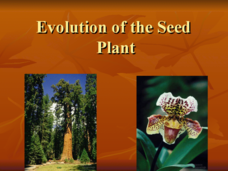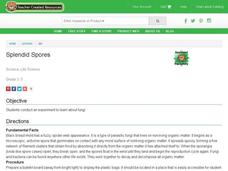Baylor College
Fungus Among Us
In order to learn that mold spores can be found in the air, observers grow bread mold and make observations for a few days. Afterward, they participate in a class discussion to arrive at the knowledge that bread spores are present in the...
Curated OER
Flower Power
Determine which plants are flowering plants with a helpful lab sheet. Kids first observe illustrations of different plants, such as a carnation and a fern, then decide which plants produce flowers, spores, or cones. Use magazine pictures...
Curated OER
Glacier Bay - The Kelp Forest
Few people get to visit Alaska's Glacier Bay, and fewer yet go underwater to explore its kelp forest. Through this presentation, viewers get to do just that! In the process, they learn about the simple structure of kelp and the diverse...
Curated OER
Evolution of Plants
This is a wonderful PowerPoint! It gives excellent details of different types of ferns and their characteristics which help them to survive and produce spores in many varied habitats.
Curated OER
Evolution of the Seed Plant
Adaptations of the plant to develop gametes best suited to different pollination atyles are detailed, The conditions needed by Sporophytes and gametophytes of different sizes are detailed, along with the development of the seed after...
Curated OER
Splendid Spores
Students explore fungi. In this fungi lesson, students take a slice of bread and leave it outside for a day. Students record their observations of the fungi on the bread the following day.
Curated OER
Introduction to Plant Reproduction
In this plant reproduction worksheet, students will label the 9 reproductive structures of moss and fern. Then students will complete 2 short answer questions based on the diagrams they labeled.
Curated OER
Non-Seed Vascular Plants
In this non-seed vascular plant instructional activity, students review the characteristics of sporophytes, lycophytes, sphenophytes, and pterophytes. This instructional activity has 19 fill in the blank, 4 true or false, and 2 short...
Curated OER
Fungi
In this fungi worksheet, students will review the different types of fungi and the structures these fungi have for reproduction and growth. This worksheet has 5 terms used in word puzzles, 5 matching, and 5 true or false questions.
Curated OER
The Diversity of Fungi
In this fungi worksheet, learners will put in sequential order the 6 steps in the mushroom life cycle using a diagram. This worksheet has 6 matching questions.
Curated OER
Viruses, Bacteria, Protists, and Fungi
In this viruses, bacteria, protists, and fungi activity, students will review the basic characteristics of each of these groups. Students will complete 7 fill in the blank questions about viruses, 6 true or false questions about...
Curated OER
Classy
Students explore the classification system in this seven lessons unit. The diversity of life forms and their characteristics are examined using a microscope. Kingdoms, classes, and families are investigated.
Curated OER
Kitchen Garbage: Mushroom Prints
For this mushrooms worksheet, students create mushroom prints by letting the spores come down onto another piece of paper. Students then answer 3 short answer questions about their spores.
Curated OER
Diversity of Microorganisms
In this biology activity, learners identify and locate various vocabulary terms related to the diversity of microorganisms from A to Z. There are 39 biology terms located in the word search.
Curated OER
MicroBiology Chp 1
In this biology worksheet, students locate and identify various vocabulary terms found in Microbiology. There are 42 words located in the puzzle.
















